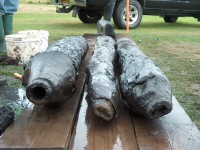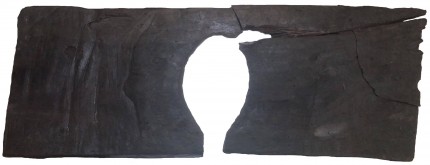 The Roman fort and settlement of Vindolanda just south of Hadrian’s Wall in Northumberland is perhaps best known for the 1,700 wooden writing tablets from the 1st and 2nd centuries A.D. that have been found there, preserved for 2,000 years in the site’s anaerobic soil. Because of the unique insight this record of daily correspondence gives us into the daily lives of the ancient Romans and Britons who lived at Vindolanda, the tablets were voted Britain’s top archaeological treasure by British Museum curators in 2003. They have been extensively studied and displayed at the Vindolanda Museum.
The Roman fort and settlement of Vindolanda just south of Hadrian’s Wall in Northumberland is perhaps best known for the 1,700 wooden writing tablets from the 1st and 2nd centuries A.D. that have been found there, preserved for 2,000 years in the site’s anaerobic soil. Because of the unique insight this record of daily correspondence gives us into the daily lives of the ancient Romans and Britons who lived at Vindolanda, the tablets were voted Britain’s top archaeological treasure by British Museum curators in 2003. They have been extensively studied and displayed at the Vindolanda Museum.
Less known are the many other wooden objects discovered at Vindolanda. Almost 1,500 artifacts have been unearthed from that blessedly waterlogged soil — cart axles, bread shovels, potter’s wheels, plank flooring, joists, that amazing inscribed barrel stave and my personal favorite, the only Roman wooden toilet seat ever discovered.
 They even found intact water pipes made of alder wood logs, bark still on them, that had been drilled through the length with an auger, creating a hollow center 5 centimeters (two inches) in diameter. There were 30 yards of pipes joined with oak junction boxes to create a network of water mains supplying Vindolanda with fresh water from a local spring. The ends of the logs were tapered to fit a hole in a block of oak. On the other side of the block another hole was drilled and another tapered log fitted into it. That was some quality joinery. With nary a single iron or lead fitting to keep the pipes together and almost two millennia after they were installed, the alder water pipes were still working when they were excavated in 2003, carrying fresh water to a building that archaeologists believe may have been a hospital. Lead pipes, even tile ones, are fairly common in the Roman world, but wood pipes are very rare — usually only the metal collars survive — and ones still in working order are rarer than hen’s teeth. As far as I was able to ascertain, the Vindolanda pipes are unique.
They even found intact water pipes made of alder wood logs, bark still on them, that had been drilled through the length with an auger, creating a hollow center 5 centimeters (two inches) in diameter. There were 30 yards of pipes joined with oak junction boxes to create a network of water mains supplying Vindolanda with fresh water from a local spring. The ends of the logs were tapered to fit a hole in a block of oak. On the other side of the block another hole was drilled and another tapered log fitted into it. That was some quality joinery. With nary a single iron or lead fitting to keep the pipes together and almost two millennia after they were installed, the alder water pipes were still working when they were excavated in 2003, carrying fresh water to a building that archaeologists believe may have been a hospital. Lead pipes, even tile ones, are fairly common in the Roman world, but wood pipes are very rare — usually only the metal collars survive — and ones still in working order are rarer than hen’s teeth. As far as I was able to ascertain, the Vindolanda pipes are unique.
As rare and historically significant as they are, none of these wooden treasures have been exhibited. Conserving, stabilizing and storing them once they have been removed from their protective environment is expensive, difficult work. Creating a display space with the technology to ensure the long-term preservation of the wooden objects while making them viewable to the public is a far greater challenge still.
 A Heritage Lottery Fund (HLF) grant has gotten the ball rolling. The Vindolanda Trust was able to secure a development grant of £20,400 ($25,400) from the HLF to develop the plans for a new addition to the site’s already excellent museum. The new space will be dedicated solely to the wooden artifacts that have been hidden away in storage for years.
A Heritage Lottery Fund (HLF) grant has gotten the ball rolling. The Vindolanda Trust was able to secure a development grant of £20,400 ($25,400) from the HLF to develop the plans for a new addition to the site’s already excellent museum. The new space will be dedicated solely to the wooden artifacts that have been hidden away in storage for years.
The popular museum will be expanded to create a new gallery with special display cases allowing temperature and humidity to be kept at safe levels. Not only will this mean their story can finally be told but it will also ensure they survive for future generations to enjoy.
Visitors will also hear the incredible survival story of the collection – from the science behind how they lasted two millennia, to their conservation and the research that is uncovering their origins.
Now, obviously the new gallery will cost vast sums more than the initial grant. This is just the first step. The Vindolanda Trust must have a fully developed and budgeted plan for the new gallery before the HLF can consider a much larger grant for the actual construction phase. Once the plans are complete, the Trust will apply for the full grant of £1,339,000 ($1,670,000). Then we can gaze in awe at the toilet seat and give it its proper respect. Some might be tempted to take a bunch of selfies squatting in front of the display case, but we’re all too dignified for those sorts of shenanigans, am I right?
